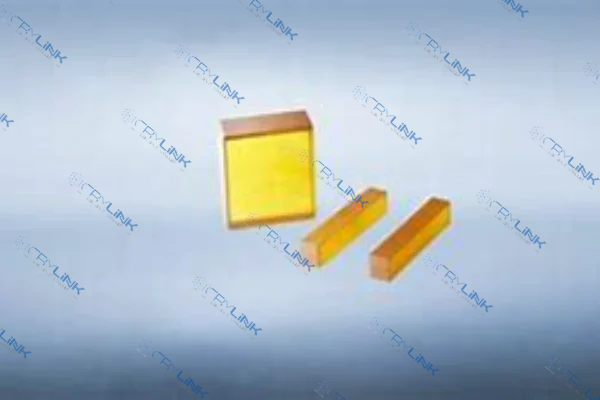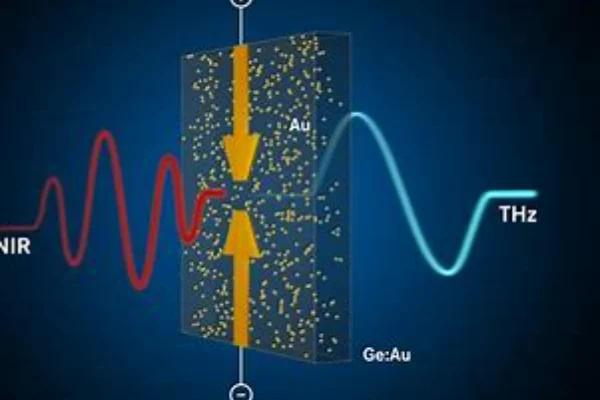Introduction to BGSe and GaSe Crystals
In the realm of nonlinear optics and frequency conversion, two materials have emerged as significant players: Barium-Germanium-Gallium Selenide (BGSe) and Gallium Selenide (GaSe) crystals. These two crystals, while sharing some similarities, possess unique properties that make them suitable for different applications.

Understanding the Structure and Composition of BGSe Crystals
BGSe crystals’ unique combination of barium, germanium, gallium, and selenium elements not only contributes to their exceptional nonlinear optical properties but also opens doors to various technological advancements. Their high nonlinear optical coefficients make them an essential component in the field of optics, particularly in frequency conversion applications like second harmonic generation (SHG) and difference frequency generation (DFG). This has led to their widespread use in infrared laser systems, where their efficiency and effectiveness are unparalleled.
In the telecommunications industry, BGSe crystals are utilized for wavelength conversion, a critical process that allows for the transformation of one wavelength into another. This capability is vital in modern communication systems, enabling more efficient data transmission and enhancing the overall performance of the network.
Furthermore, the structure and composition of BGSe crystals make them suitable for research and development in various scientific fields. Researchers are exploring new ways to harness their properties, leading to innovations in areas such as medical imaging, environmental monitoring, and defense technology. The potential applications of BGSe crystals extend beyond traditional domains, reflecting their versatility and adaptability.
The synthesis and understanding of BGSe crystals also represent a significant achievement in material science. The ability to combine specific elements into a crystal structure that exhibits such remarkable properties is a testament to the progress in the field of crystallography and materials engineering. It highlights the importance of interdisciplinary collaboration, where chemistry, physics, and engineering converge to create solutions that have a profound impact on technology and society.
In conclusion, BGSe crystals are more than just a material with intriguing optical properties. They are at the forefront of technological innovation, contributing to advancements in various fields from telecommunications to medical imaging. Their unique structure, composition, and properties make them a subject of ongoing research and exploration, promising even more exciting developments in the future. The story of BGSe crystals is a story of human ingenuity, scientific curiosity, and the relentless pursuit of knowledge and innovation that continues to shape our world.

Delving into the Structure and Composition of GaSe Crystals
GaSe crystals, composed of gallium and selenium, are binary crystals that have carved a niche for themselves in the world of nonlinear optics. Renowned for their large nonlinear optical coefficients and wide transparency range, these crystals have become a vital component in various optical applications.
The nonlinear optical properties of GaSe crystals, particularly their high second-order nonlinear susceptibility, make them suitable for frequency conversion processes. This ability to convert frequencies, especially in the mid-infrared region, has led to their extensive use in a wide array of technological applications. From enhancing the efficiency of optical systems to enabling new functionalities, GaSe crystals have proven to be indispensable.
One of the primary applications of GaSe crystals is in nonlinear optical devices such as optical parametric oscillators (OPOs). These devices rely on the unique properties of GaSe crystals to generate new frequencies from existing ones, a process that is crucial in various scientific and industrial applications. The efficiency and adaptability of GaSe crystals in OPOs have made them a preferred choice among researchers and engineers alike.
Furthermore, GaSe crystals are used in terahertz wave generation, a field that has seen significant growth in recent years. Their wide transparency range allows them to function effectively in this domain, contributing to advancements in areas such as security scanning, medical imaging, and materials characterization. The ability of GaSe crystals to operate in the terahertz frequency range opens up new possibilities and challenges, sparking innovation and exploration.
The synthesis and understanding of GaSe crystals also represent a convergence of various scientific disciplines. Material scientists, physicists, and engineers work together to explore and harness the unique properties of these crystals. This collaborative effort has led to breakthroughs in our understanding of nonlinear optics and has paved the way for new technologies that were previously unimaginable.
In addition to their current applications, GaSe crystals hold promise for future innovations. Researchers are continually exploring new ways to utilize their unique properties, leading to potential advancements in renewable energy, communication systems, and even quantum computing. The ongoing research into GaSe crystals is a testament to their potential and a glimpse into a future where their applications could be even more far-reaching.
In the broader context, GaSe crystals symbolize the power of human curiosity and the relentless pursuit of knowledge. They remind us that even the most complex and abstract scientific concepts can have practical applications that impact our daily lives. From enhancing medical diagnostics to improving communication networks, GaSe crystals are a shining example of how science and technology can come together to create solutions that shape our world.
In conclusion, GaSe crystals, with their unique structure, composition, and properties, continue to be a subject of fascination and exploration. Their contributions to nonlinear optics and their potential for future innovations make them a critical component in the ever-evolving landscape of science and technology. The story of GaSe crystals is far from over, and as we delve deeper into their mysteries, we can expect even more exciting discoveries and applications in the years to come.

Comparative Analysis of BGSe and GaSe Crystals
The comparative analysis of BGSe and GaSe crystals reveals a fascinating interplay of similarities and differences that make each of them suitable for specific applications. While both crystals are renowned for their nonlinear optical properties, they differ in several key aspects that define their unique roles in various technological domains.
BGSe crystals, with their higher nonlinear optical coefficients, stand out as more efficient in frequency conversion applications. This efficiency is a result of their specific structure and composition, which allows them to excel in tasks such as second harmonic generation (SHG) and difference frequency generation (DFG). Whether in laser systems or telecommunications, BGSe crystals’ superior nonlinear optical coefficients make them a preferred choice for applications that demand high efficiency in frequency conversion.

On the other hand, GaSe crystals are known for their wider transparency range, making them more versatile in a broader spectrum of applications. This wide transparency range enables GaSe crystals to function effectively in terahertz wave generation, a field with growing importance in areas such as medical imaging, security, and materials analysis. The ability of GaSe crystals to operate across a broader frequency range opens up new possibilities and makes them a valuable asset in various scientific and industrial applications.
The differences between BGSe and GaSe crystals are not merely academic but have practical implications in the selection of materials for specific applications. For instance, a researcher or engineer working on a project that requires efficient frequency conversion might opt for BGSe crystals due to their higher nonlinear optical coefficients. Conversely, a project that requires versatility across a wide frequency range might benefit more from the unique properties of GaSe crystals.
These distinctions also reflect the complexity and richness of the field of nonlinear optics. The study of BGSe and GaSe crystals is not just about understanding their individual properties but also about appreciating how these properties interact and complement each other. It’s a dynamic field where the choice of materials can significantly impact the outcome of a project, and where a deep understanding of the characteristics of different crystals can lead to innovative solutions.
In the broader context, the comparative analysis of BGSe and GaSe crystals serves as a reminder of the diversity and richness of the natural world. It shows that even within a specific field like nonlinear optics, there is a wide array of materials with unique properties, each with its own role and potential. It’s a testament to human ingenuity and the power of science to explore, understand, and harness these materials for the betterment of society.
In conclusion, the comparison between BGSe and GaSe crystals is not just an academic exercise but a practical guide to understanding their unique roles and applications. The differences in their nonlinear optical coefficients and transparency range make them suitable for different purposes, reflecting the complexity and diversity of the field of nonlinear optics. As we continue to explore and utilize these remarkable crystals, we can expect even more exciting developments and innovations that will shape the future of technology and our understanding of the world around us.
Choosing Between BGSe and GaSe Crystals
The choice between BGSe and GaSe crystals ultimately depends on the specific requirements of the application. BGSe crystals are more suitable for applications requiring high efficiency in frequency conversion, while GaSe crystals are more versatile due to their wider transparency range.

Conclusion
In conclusion, both BGSe and GaSe crystals are valuable materials in the field of nonlinear optics and frequency conversion. While they share some similarities, their unique properties make them suitable for different applications. Understanding these differences is crucial in selecting the right crystal for your specific needs.
Frequently Asked Questions
- Q1: What are the main applications of BGSe crystals?
- A1: BGSe crystals are primarily used in infrared laser systems and telecommunications for wavelength conversion.
- Q2: What are the main applications of GaSe crystals?
- A2: GaSe crystals are commonly used in nonlinear optical devices and terahertz wave generation.
- Q3: Which crystal has a higher nonlinear optical coefficient?
- A3: BGSe crystals have higher nonlinear optical coefficients than GaSe crystals.
- Q4: Which crystal has a wider transparency range?
- A4: GaSe crystals have a wider transparency range compared to BGSe crystals.
- Q5: How do I choose between BGSe and GaSe crystals?
- A5: The choice depends on the specific requirements of the application. BGSe is more efficient in frequency conversion, while GaSe is more versatile due to its wider transparency range.

Frank
Frank graduated from the University of Shanghai for Science and Technology, majoring in optics. As a technical engineer at Crylink Company, he deeply understands crystal materials and laser components.
Related Video(s) with this Article
Related Product(s) with this Article
Related Application(s) with this Article
